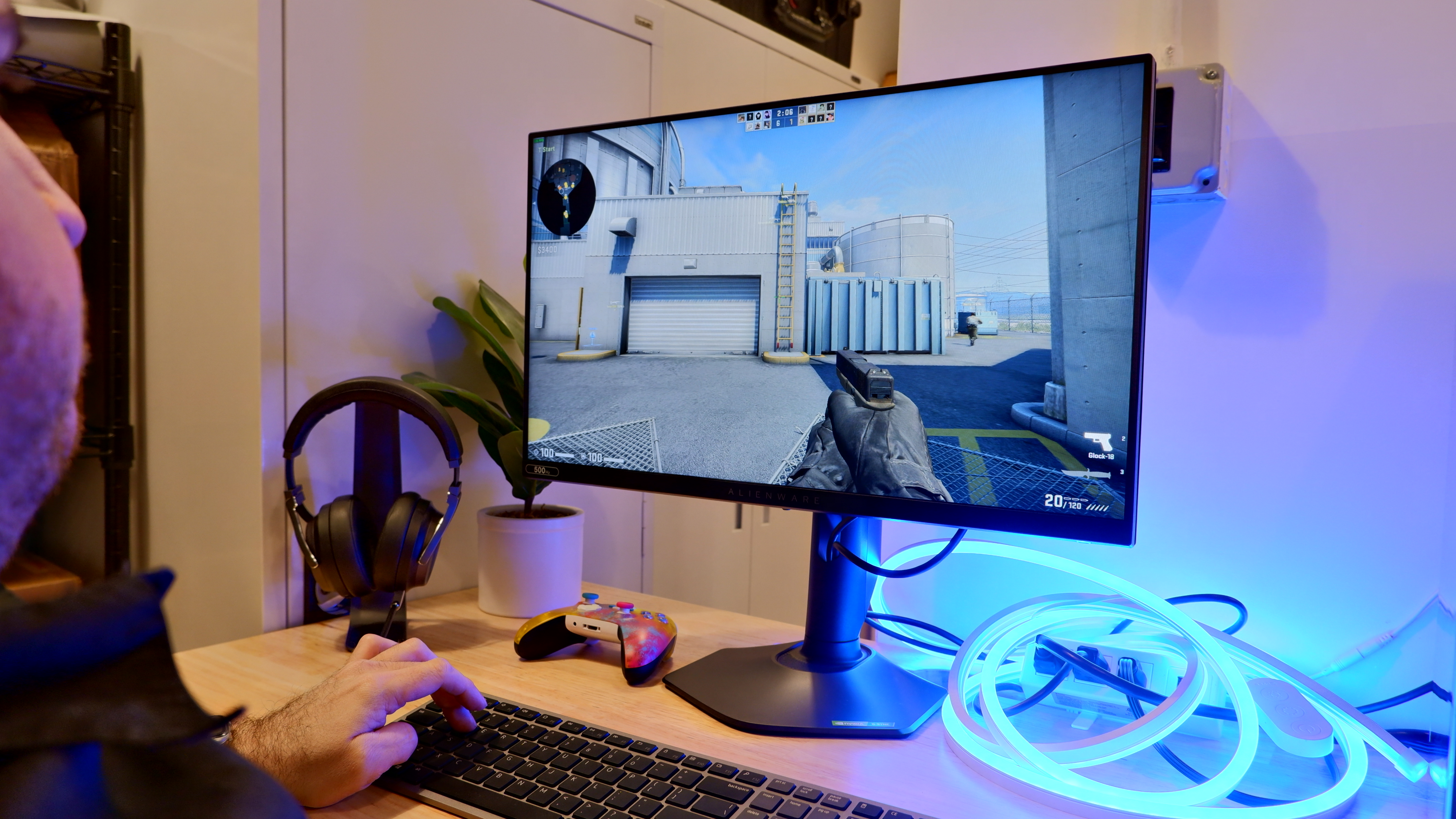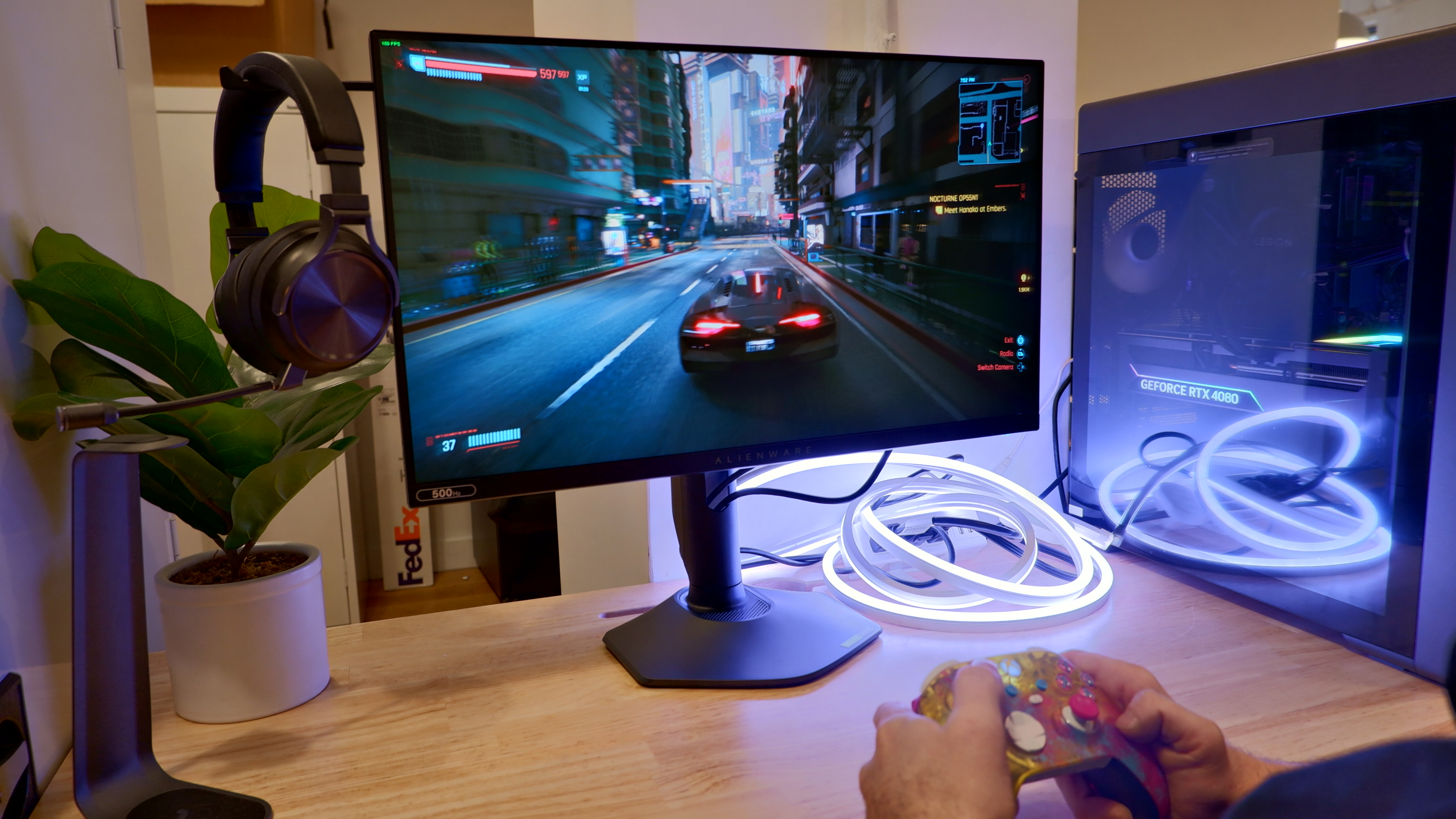
The Alienware 500Hz (AW2524H) is the fastest gaming monitor I’ve ever tested. I was skeptical when I checked out the monitor during Dell’s CES 2023 preview event in NYC. 500Hz seemed unnecessarily high, even for professional players who demand high refresh rates and low latency. But after extensive time with the AW2524H, I can’t deny that it delivers the goods.
My full review is still in progress but I wanted to share some of my initial thoughts. While it performs as advertised, it’s only useful to a niche audience. Though I enjoyed the buttery-smooth response time the monitor provides, I wouldn’t pay the $829 asking price for this monitor when I can get a monitor nearly as good in every respect (save that crazy-high refresh rate) for hundreds less. Then again, I’m not the competitive gamer Dell is marketing this monitor at.
Price concerns aside, the Alienware 500Hz is a great peripheral that will find a home in our best gaming monitors list. It’s not for everyone, but it lives up to its promises. Below, I’ll go over what I like and don’t like about the AW2524H. You can read all about it when my review is live, but I hope this piece gives you an idea of what you can expect and if you should invest in this pricy gaming peripheral.
Blazing-fast performance… for a price
The AW2524H has a native refresh rate of 480Hz, but you can overclock it to 500Hz via the display settings if you're playing something you think will go higher than 480 frames per second. I thought the native 240Hz seen in the displays of notebooks like the 7 best gaming laptops of CES 2023 was impressive, but Alienware’s monitor is more than twice as fast. But does that make a difference?

Playing Doom Eternal on the AW2524H felt great because of how buttery-smooth it ran on the Alienware 500Hz — with frame rates staying at a consistent 130 fps. This game requires you to constantly be on the move and I had no trouble staying away from the demonic hordes. Shooting my weapons also felt more precise. I won’t say the experience was transformative, but I can’t deny that the monitor’s high refresh rate helped me play better — even nominally.
But is there a noticeable difference between the native 480Hz and overclocked 500Hz? Not that I could tell, but then again, I’m not a professional player. But I'm sure those same professionals will notice a difference since they’re more sensitive to things like frame and refresh rates. I didn't notice a big change between 480Hz and 500Hz, but the experience is smoother in comparison to the 144Hz gaming monitors I'm used to.
I said this in my review, but one of the sticking points with the AW2524H is that you need a beefy gaming rig to maximize its potential. The Lenovo Legion Tower 7i Gen 8 I used while testing the monitor packs a 13th Gen Intel Core i9 CPU and an RTX 4080 GPU — and costs a hefty $3,349. This is on top of the AW2524H’s $829. Professional gamer or not, that’s a lot of money.
A serviceable display
The monitor’s 500Hz refresh rate is the AW2524H’s main selling point. To achieve such a lofty refresh rate, the monitor skimps on features like an OLED display and high resolutions. It’s a good display that presents a clear, sharp image but it won’t stun you. Then again, this monitor isn’t here to wow you with exceptional picture quality.
When we brought the monitor into our testing lab and pointed our Klein-10A colorimeter at it, we found that the AW2524H’s display achieved an average brightness of 346 nits of brightness in Standard mode. That’s dimmer than the $899 Sony Inzone M9, which averaged 395 nits of brightness in its Standard mode. However, Alienware’s monitor outshines the $999 LG UltraGear 27, which averaged a paltry 203 nits of brightness.
In Standard mode, the display achieved 113% of the sRGB color gamut and 80.7% of the DCI-P3 color gamut (closer to 100% is best). Its Delta-E value reached 0.14 (closer to 0 is better). The other modes stayed within this range, though G-Sync Esports had the highest sRGB and DCI-P3 averages (133% and 94.3%, respectively).
In comparison, the Sony Inzone M9 reached 145% of the sRGB color gamut and 102.9% of the DCI-P3 color gamut in its Standard mode. Its Delta-E value reached 0.31. The Gigabyte M27Q X (173.3% / 122.8%) achieved higher values than both Alienware and Sony’s monitors.
The AW2524H’s picture quality isn’t its strongest attribute. The LG UltraGear 27 doesn’t get as bright as Alienware’s monitor, but it has more vibrant colors and a sharper display. That last point might be unfair since LG’s monitor has a resolution of 2.5K compared to the Alienware monitor’s 1080p, but I’m willing to trade refresh rate for a higher resolution.
Bottom line
When considering the Alienware 500Hz, the most important question you need to ask yourself is: Do you need a 500Hz gaming monitor? The high refresh rate combined with low latency certainly made games feel better in my experience. To that end, it’s a phenomenal gaming monitor for professional gamers who value performance above all else.
I think the Alienware 500Hz is great at what it does but it's pricy at $829. Dell has the $449 Alienware 25, which also features a 24.5-inch 1080p display with a 0.5ms response time. It doesn't have a 500Hz refresh rate, but 360Hz isn't anything to complain about. If I had to choose between the two, I'd get the Alienware 25.
As for the future of 500Hz gaming monitors, the Asus ROG Swift PRO PG248QP is on the horizon. Interestingly enough, this was announced before the Alienware 500Hz but Dell beat Asus to the punch and released its monitor first. I want to put that device through its paces to see how it stacks up. But for now, the AW2524H has the 500Hz gaming monitor space all to itself. If you're a professional gamer, it's worth considering. Just be prepared to pay a premium.







